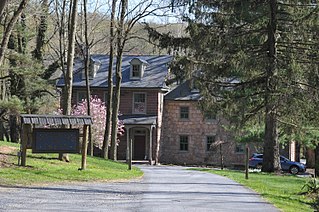
Speedwell Forge Mansion, also known as Speedwell Forge Homestead, is a historic home located at Elizabeth Township, Lancaster County, Pennsylvania. The ironmaster's mansion was built about 1760, and is a 2½-story, four bay wide and two bay deep, brownstone and fieldstone dwelling in the Georgian style. It was expanded about 1795 with a Georgian/Federal style wing. Also on the property are a contributing stone summer kitchen, stone and frame workshop, stone paymaster's office c. 1795), and stone privy.
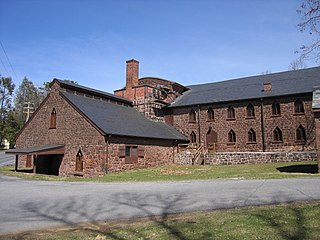
Cornwall Iron Furnace is a designated National Historic Landmark that is administered by the Pennsylvania Historical and Museum Commission in Cornwall, Lebanon County, Pennsylvania in the United States. The furnace was a leading Pennsylvania iron producer from 1742 until it was shut down in 1883. The furnaces, support buildings and surrounding community have been preserved as a historical site and museum, providing a glimpse into Lebanon County's industrial past. The site is the only intact charcoal-burning iron blast furnace in its original plantation in the western hemisphere. Established by Peter Grubb in 1742, Cornwall Furnace was operated during the Revolution by his sons Curtis and Peter Jr. who were major arms providers to George Washington. Robert Coleman acquired Cornwall Furnace after the Revolution and became Pennsylvania's first millionaire. Ownership of the furnace and its surroundings was transferred to the Commonwealth of Pennsylvania in 1932.

The Stiegel-Coleman House, also known as Elizabeth Farms, is an historic mansion house which is located at 2121 Furnace Hills Pike, just north of Brickerville, Pennsylvania.

The Coventryville Historic District is a historic district and historic village in Chester County, Pennsylvania, United States that enjoyed a significant role in the early American metal industry.

The Centre Furnace Mansion is listed on the National Register of Historic Places and is the headquarters of the Centre County Historical Society, located in State College, Pennsylvania. The Mansion, the ironmaster's residence for Centre Furnace, has been restored and is furnished to reflect the period of residency of ironmaster Moses Thompson and his family, 1842–1891. A mansion in miniature, identical to the original and scaled one inch to one foot, is on permanent display. This historic mansion and nearby iron furnace stack represent the 18th century beginnings of the charcoal iron industry in the central Pennsylvania area, and the 19th century beginnings of the Pennsylvania State University.
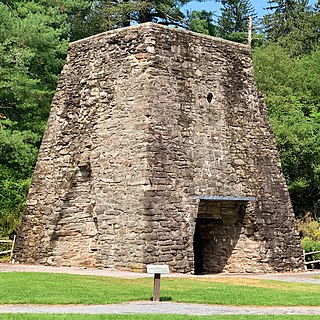
The Pine Grove Iron Works was a smelting facility in southcentral Pennsylvania during the Industrial Revolution. The works is notable for remaining structures that are historical visitor attractions of Pine Grove Furnace State Park, including the furnace stack of the Pine Grove Furnace. The site was listed on the National Register of Historic Places on April 13, 1977 for its significance in architecture and industry. It includes seven contributing buildings, two structures, fourteen sites, and two objects.

Curtin Village, also known as Eagle Ironworks, is a national historic district located in Boggs Township, Centre County, Pennsylvania. The district includes eighteen contributing buildings and three contributing structures in Curtin.

The Pennsylvania Furnace Mansion, also known as the Lyon Mansion, is an historic, American home that is located in Franklin Township in Huntingdon County, Pennsylvania.

Huntingdon Furnace is a national historic district and historic iron furnace and associated buildings located at Franklin Township in Huntingdon County, Pennsylvania. It consists of seven contributing buildings and one contributing structure. They are the iron furnace, office building, the ironmaster's mansion, log worker's house, a residence, the farm manager's residence, the grist mill and the miller's house. The iron furnace was moved to this site in 1805, from its original site one mile upstream. It measures 30 feet square by 30 feet high. The ironmaster's mansion was built in 1851, and is a 2 1/2-story, "L"-shaped frame dwelling. The grist mill dates to 1808, and is a 3 1/2-story, rubble stone building measuring 50 feet by 45 feet. The furnace was in operation from 1796, until it ceased operations in the 1880s.

The Juniata Iron Works, also known as the Hatfield Iron Works, is a national historic district that is located in Porter Township in Huntingdon County, Pennsylvania.

The Paradise Furnace, also known as the Mary Anne Furnace, is a national historic district that is located in Trough Creek State Park in Todd Township in Huntingdon County, Pennsylvania.

Codorus Forge and Furnace Historic District, also known as Hellem (Hellam) Forge, is a historic iron forge and national historic district located at Hellam Township in York County, Pennsylvania. The district includes four contributing buildings, one contributing site, and one contributing structure. The contributing buildings are the iron furnace, charcoal house, ruins of works' houses, ironmaster's house and furnace office, privy, forge (1800), and ruins of unknown structures. The furnace measures approximately 30 feet square at the base and 12 feet high. The ironmaster's house is a 2 1/2-story, stuccoed stone building, nine bays wide and one room deep. The Hellem (Hellam) Forge was first established in 1765.
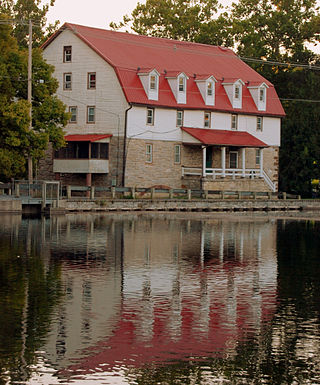
Boiling Springs Historic District is a national historic district located at Boiling Springs, Cumberland County, Pennsylvania. The district includes 127 contributing buildings, 1 contributing site, and 1 contributing structure associated with its role as an early iron manufacturing center and surrounding residential areas of Boiling Springs. Most of the contributing buildings date to the mid-19th century starting in 1845, with a few dated to the early period of development. The oldest buildings are a grist mill, the ironmaster's, Michael Ege, mansion (1795), and the restored Boiling Springs Tavern (1832). Other notable non-residential buildings include the former stone stables (1829) and forge building (1850s). Residential areas include notable examples of the Bungalow/craftsman, Late Victorian, and Federal styles. The contributing structure is a stone three-arched bridge (1854).

Poole Forge is an historic, American iron forge complex and national historic district that is located in Narvon, Caernarvon Township, Lancaster County, Pennsylvania.

Windsor Forge Mansion, also known as Windsor Place, is an historic, American home and national historic district located in Caernarvon Township, Lancaster County, Pennsylvania.

Chickies Historic District is a national historic district located at East Donegal Township, West Hempfield Township, and Marietta, Lancaster County, Pennsylvania, United States. The district includes 32 contributing buildings, 16 contributing sites, and four contributing structures in three areas. They are: 1) floodplain along the Susquehanna River containing archaeological remains of iron furnaces; 2) the "Ironmasters' Hill" area of Marietta with five residences associated with ironmasters ; and 3) the Donegal Creek area with farmland, iron pits, and limestone quarries owned by the ironmasters.

The Swatara Furnace is a historic iron furnace and 200-acre national historic district located along Mill Creek, a tributary of the Swatara Creek in Pine Grove Township, Schuylkill County, Pennsylvania.
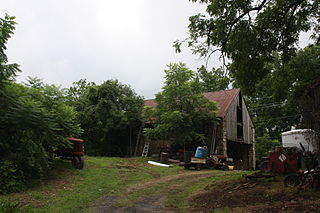
Dale Furnace and Forge Historic District, also known as Dale Iron Works and Mt. Chalfont Furnace, is a historic "iron plantation" and national historic district located in Washington Township, Berks County, Pennsylvania. The district encompasses six contributing buildings and one contributing site. They are a stone horse barn, stone and frame bank barn, ironmaster's mansion, smokehouse and wash house (1827), stone worker's house (1830), and counting house. The archaeological site includes the ruins of a worker's house, the stone furnace stack, bank iron furnace, forge foundations and race, and remnants of dam breast. The furnace remained in blast until about 1822, and the Dale Forge was in operation until 1868.
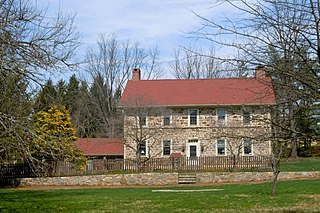
The Vincent Forge Mansion, also known as Young's Forge Mansion and the Kerry Dell Farm, is an historic, American home that is located in East Vincent Township, Chester County, Pennsylvania.

The Reading Furnace Historic District is a national historic district that is located in Warwick Township and East Nantmeal Township, Chester County, Pennsylvania.
























